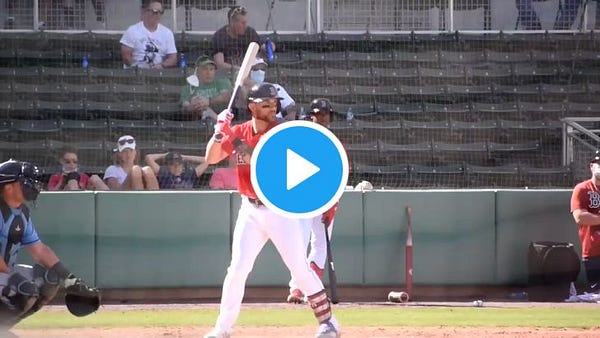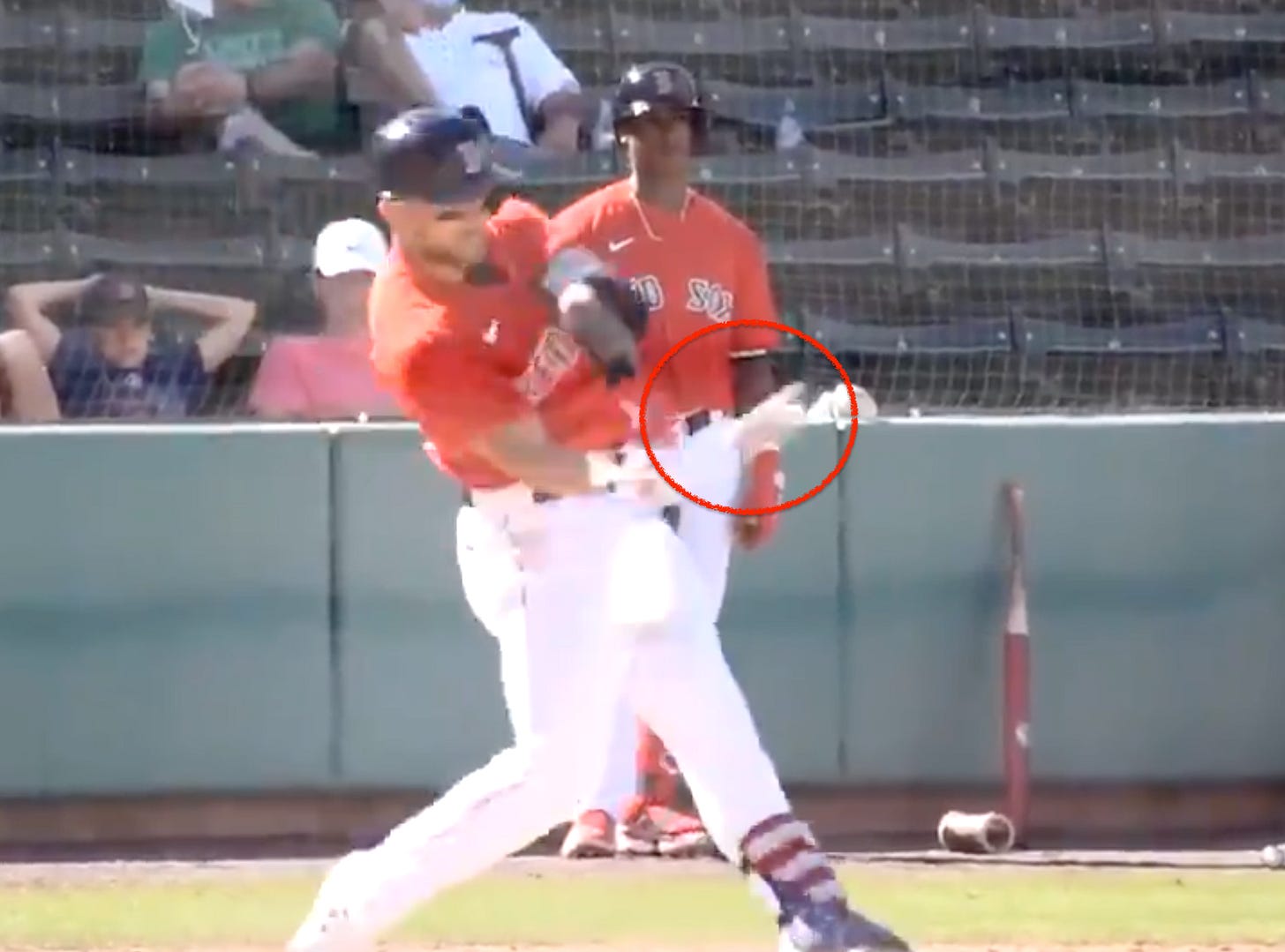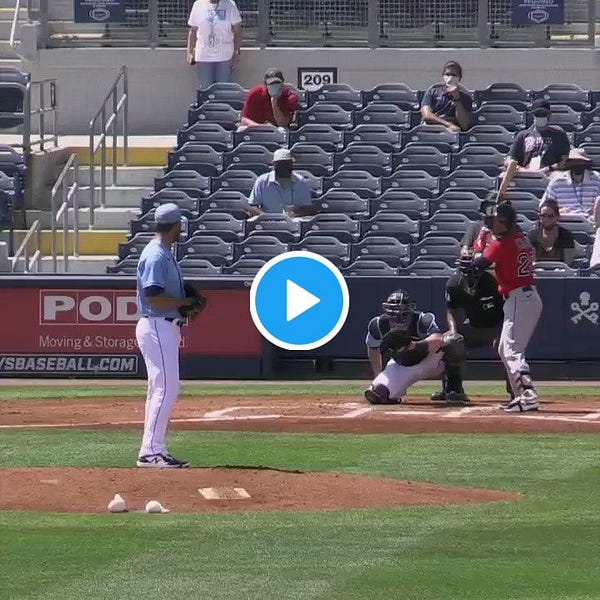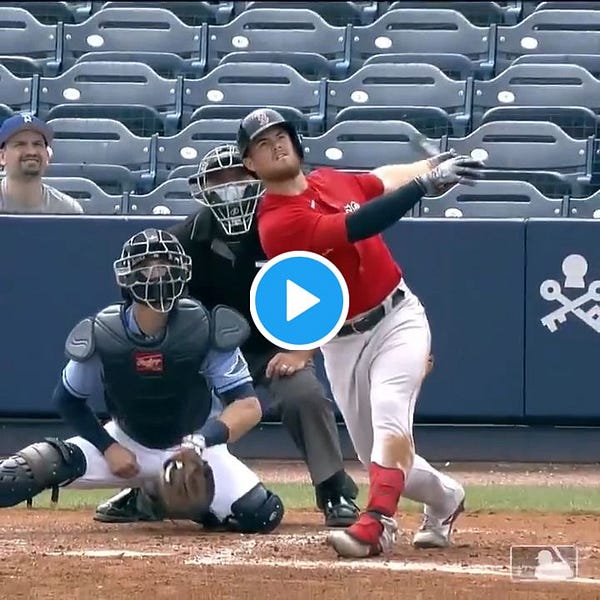I’m not one of those roster shenanigans guys. I’m far more interested in performance. Is a guy any good, why or why not? Yesterday Michael Chavis hit another homer, his sixth, tied for the Grapefruit League lead. I suppose that’s an accomplishment, certainly more than I’ve done with my life so far, but how meaningful is it? And more to the point, should it be enough for Chavis to make the roster?
I’d submit that six homers, while nice, aren’t enough on their own, but if they represent some change in Chavis’ style or hitting aptitude, then we might be talking. So let’s see what we can find.
Let’s put aside what Michael Chavis can and can’t do in the field and focus on his ability at the plate, and if we’re being honest with ourselves, that’s what’s going to make or break his major league career anyway. Chavis is a power hitter, one who is ultimately going to live and die by his ability to hit extra base hits. He doesn’t walk a ton but he does strike out a lot. So let’s look at what he’s done in his time in the majors so far.
Chavis has 23 homers in 137 major league games which is pretty good. Those homers have tended to come on pitches located in similar places over the plate. Baseball Savant keeps these handy images on where and how players have made (or not made) contact on pitches in specific parts of the strike zone, so let’s take a look at this one.
Chavis is a right handed hitter so he would stand on the left side of the plate, but that almost doesn’t matter here because, as you can see, Chavis hits balls over the middle really well. The low pitches over the middle of the strike zone are his absolute favorites, as you can see here in this chart which shows his expected batting average broken up by different pitch locations.
Again we can see that low pitch over the middle of the plate is his favorite. Of course this is effected by the kind of pitch and the count and how well Chavis is hitting at the moment, and a bunch of other factors besides, but if you were pitching to Michael Chavis, there’s pretty much one location you would want to avoid, and that is down and over the middle.
Chavis might be a better candidate for the opening day roster if he improved his hitting skills, improved his ability to hit pitches in different locations, in effect closed some of the holes in his swing. With the caveat that spring training homers aren’t necessarily a telling sample size, it could be instructive to see where those pitches have been located. Has Chavis improved his ability to make hard contact at all? Let’s see!
The first problem is these are spring training homers and so not all of them are televised, and even the ones that are televised often suffer from lousy angles and mediocre camera work. Here’s our first example of that, this homer from Chavis on February 28. I can’t embed the video so but it doesn’t really matter as you’ll see from this screenshot
I’ve watched it 20 times but I have no idea where that pitch was exactly. It sure looks over the plate, but it might be inside. It could be belt high, it could be below the knees, I honestly have no idea. Good hit though! Let’s move on to the next one.
This view is better, but as it was filmed by, presumably, a fan in the stands, it’s still not exactly what we’d hope to use towards informed analysis. And yet, it’s a poor archeologist who blames the tools, so here we go.
This is the best I could do. I usually try to shrink these images so they won’t be so onerous but I’m leaving this one extra large so it’s clear, or as clear as possible. It’s really hard to see because Chavis and the player standing behind him are both wearing bright white pants, but that’s the ball bouncing upwards off his bat. You can see that the pitch was about belt high, though whether it was inside, outside, or over the middle isn’t one I can answer.
Anyway, that’s homer number two. Don’t worry though, these do get clearer. Here’s a homer Chavis hit about a week ago off of Tampa.
The catcher’s mitt is instructive here. You can see, split seconds after contact, where he was expecting to catch the pitch.
Looks like belt high, middle to me. On to the next one!
The camera angle makes inside and outside hard to see, but you can definitely tell the pitch was pretty low. This screenshot confirms that.
See where the catcher’s mitt is set up? That’s at the knees or even a hair below. (Watch the video and you’ll see the pitch isn’t nearly as inside as this screenshot makes it seem.)
One more!
Chavis’s homer is the second one on the video. Here’s a screenshot just following the moment of contact.
Again, look at the catcher’s mitt. Just above the knees, and though the camera angle makes discerning inside and outside difficult, this one looks like pretty close to the middle of the plate, maybe a smidge inside.
Those are the five homers I could find video for. There’s one more, but I couldn’t find a video or even a still of it. (If you can, throw it in the comments!) So let’s review.
???
Belt high, that’s about all I got
Belt high, middle
Knee high, inside corner?
Knee high, middle
I was all set to draw red circles on another image for you, but then I noticed this.
Take a look at those three red squares. Pretty much exactly where those pitches were thrown with potentially two exceptions. The first homer… no idea. I’d guess it was over the middle of the plate based on the catcher and slowing the video down as much as I can, but I can’t be sure. But that seems to fit the pattern, potentially. The only one that stands out is homer number four, which might be on the inside corner or it might be in Chavis’s big power zone, low and over the middle.
What does all this show? Well, it sure doesn’t prove anything, but I knew six hits weren’t going to prove anything before I started this. Instead of saying what I’m seeing, let’s go to what I’m not seeing, and that is Chavis hitting pitches he’s not hit before.
Yes he should absolutely get credit for the contact he’s making. He’s having a heck of a spring and part of being a good hitter is making good on the hittable pitches you see, not fouling them off, or rolling them over, but pounding them over the wall, and Chavis is clearly doing that. But because these homers don’t look markedly different than what he’s done in his major league career to date, it’s hard for me to be too excited.
Chavis is a flawed hitter, and he’s likely to remain one. My guess, and it’s only a guess, is he’s been able to take advantage of some bad pitching, some pitchers who either can’t quite command on a major league level, or who aren’t reading scouting reports because you probably don’t read scouting reports in spring training. The quality of pitching Chavis has seen so far in spring is something in between High-A and Double-A according to Baseball Reference, which anecdotally supports that theory.
Good hitters not only make good on the hittable pitches on the rare occasions they show up, but they avoid getting themselves out for as long as possible in order to increase the chances they see a hittable pitch. Chavis has two walks and 12 strikeouts so far, so it’s hard to say he’s doing that successfully.
In the end, I admit I am curious. I’d like to see Chavis play because I do think there is some untapped talent in there. If you don’t buy that and I can see why you wouldn’t then putting him on the bench and using him as a backup infielder and right-handed pinch hitter makes sense. So does sending him to Triple-A, which would accomplish the duel tasks of not playing him every day in Boston but playing him every day somewhere, namely Triple-A.
We’ll see what the Red Sox do, but I don’t think these six homers prove Michael Chavis has turned over a new leaf.


















Nice analysis, and a wise warning to take ST numbers with a grain of salt. Barring injuries or a trade, Chavis seems likely to split this season between Boston and Worcester. He has options left, unlike the other Sox backup infielders, and he can’t play SS. He has big power, of course, and if he makes adjustments to close the holes in his swing he could force the Sox to think differently about him. As it is, he’s probably Plan B if Dalbec struggles.